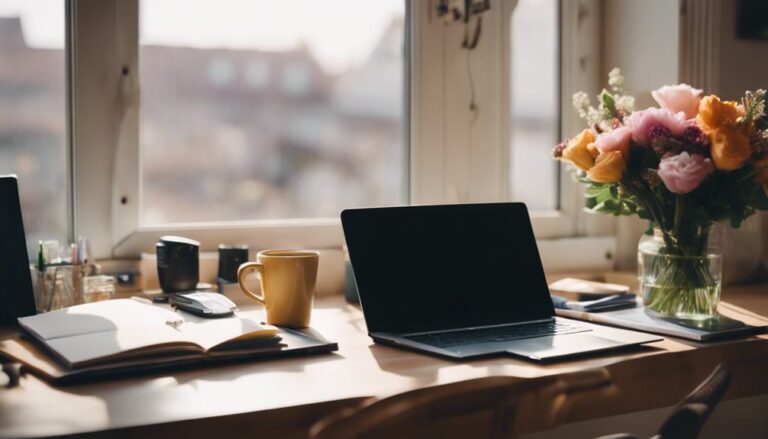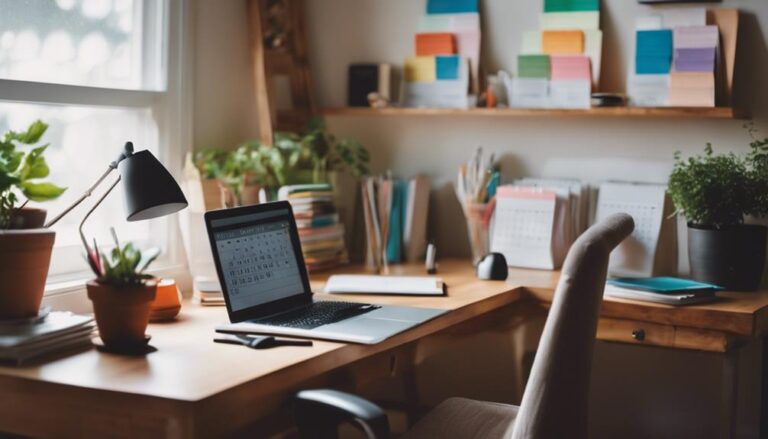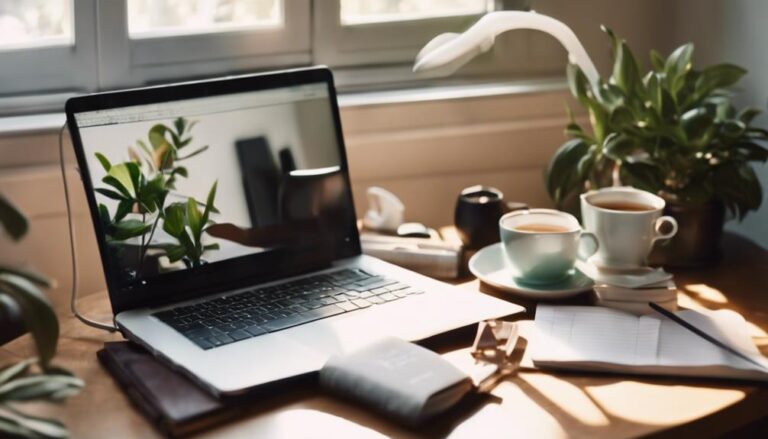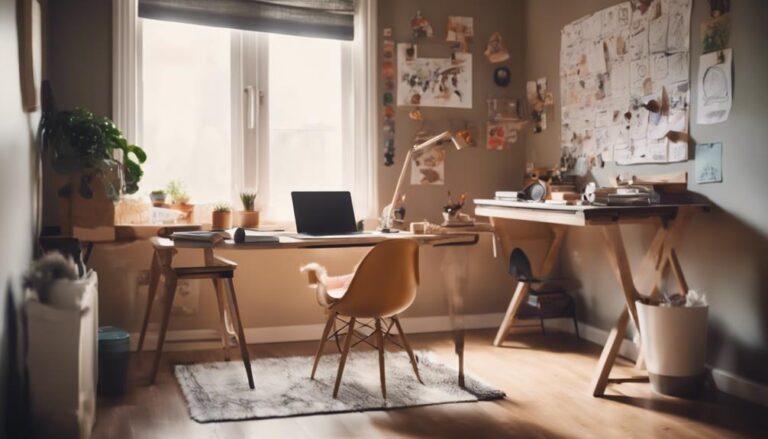I've found that a clutter-free home office can boost productivity and reduce stress to a great extent. First, I keep only essentials and prioritize functionality over sentimentality. I organize supplies by frequency of use, keeping frequently used items within reach. Sorting and categorizing items like supplies, paper, and electronics helps streamline my space. For cables, I use labels and cable management tools. I set decluttering goals and visualize a tidy workspace to stay motivated. Digitizing documents reduces paper clutter. Finally, I build habits to maintain a clutter-free environment. For more detailed strategies, consider exploring further steps.
Key Takeaways
- Keep only essential items that support work tasks to boost productivity.
- Organize supplies by frequency of use and keep frequently used items within arm's reach.
- Use bins, trays, and dividers for efficient storage and implement a labeling system.
- Manage and label cables using cable management tools to improve aesthetics and functionality.
- Break decluttering tasks into smaller segments and set achievable goals for steady progress.
Keep Only Essentials
When organizing your home office, it's crucial to keep only the essentials to maintain a productive workspace. I started by identifying essential items based on their functionality and necessity in my daily work routine.
Everything that didn't serve a purpose or boost my productivity was eliminated. I focused on maintaining a clutter-free environment by removing duplicates and items I hadn't used in a long time.
By prioritizing functionality over sentimentality, my home office became a streamlined space. This approach guaranteed that only items directly supporting my work tasks remained.
The result was a more efficient and innovative workspace, where every element had a clear role in enhancing my productivity.
Prioritize Practicality
Having streamlined my home office by keeping only the essentials, I now focus on prioritizing practicality to maximize efficiency. First, I organize my office supplies based on how frequently I use them. Frequently used items like pens and notebooks are kept within arm's reach. For practical storage solutions, I utilize bins, trays, and dividers. Implementing a labeling system guarantees I can quickly find what I need.
Here's how I categorize my supplies:
| Category | Location | Storage Solution |
|---|---|---|
| Frequently Used | Desk | Trays |
| Occasionally Used | Nearby Drawer | Dividers |
| Rarely Used | Closet | Labeled Bins |
Sort and Categorize
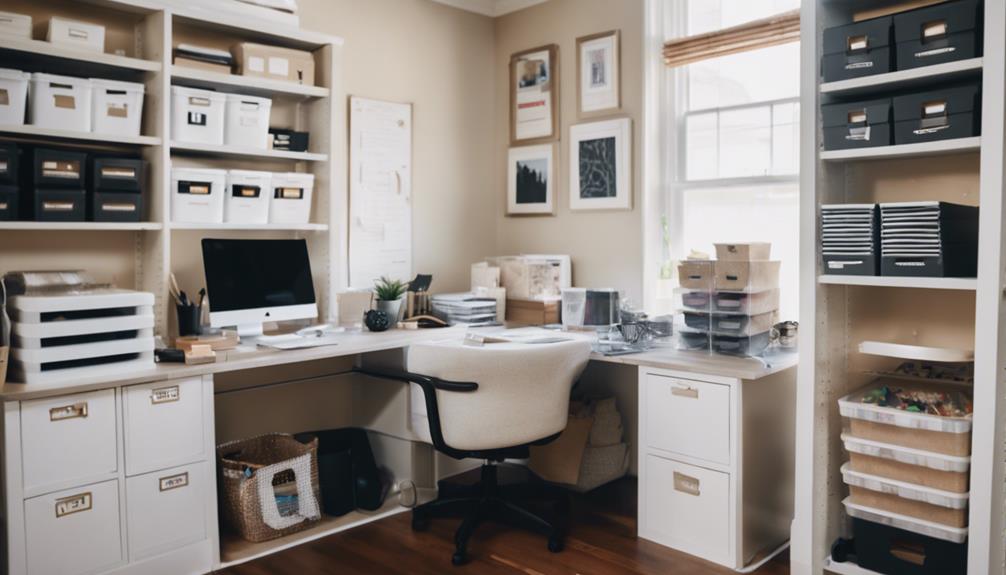
To create a more organized and efficient workspace, I start by sorting and categorizing all the items in my home office. I divide everything into categories like office supplies, paper, electronics, and personal items. By grouping similar things together, I streamline my office space and make it easier to find what I need.
I also consider how often I use each item to decide what stays within easy reach and what can be stored away. This decluttering method helps me determine which essentials I need, which items can be recycled or donated, and what should be relocated.
Through systematic home organization, I transform my home office into a functional, clutter-free zone ready for innovation.
Manage Cables
In managing cables, I start by labeling each cord to prevent confusion and save time.
Then, I use cable management tools to keep everything organized and tangle-free.
This not only improves the look of my workspace but also enhances its functionality.
Label and Organize Cords
Labeling and organizing cords is essential to maintaining a tidy and efficient home office. By clearly labeling cords with tags or color-coded stickers, I can easily identify and manage cables, reducing confusion and improving efficiency. Implementing cable management systems, such as cable organizers and cable clips, prevents tangles and keeps cords neatly arranged. Using household items like binder clips or Velcro ties also helps to organize cords effectively. This not only reduces tripping hazards but also prevents potential damage to my electronic devices. Here's a quick overview of useful tools:
| Item | Purpose | Benefit |
|---|---|---|
| Tags | Label cords | Easy identification |
| Color-coded stickers | Label cords | Visual organization |
| Cable organizers | Cable management systems | Prevents tangles |
| Cable clips | Cable management systems | Keeps cords in place |
| Velcro ties | Organize cords | Neat storage |
Utilize Cable Management Tools
Investing in cable management tools greatly enhances the organization and functionality of my home office. By keeping my cords organized and tangle-free, I not only improve the overall aesthetics but also prevent potential electronic issues that can arise from messy cables.
I utilize cable ties, clips, and sleeves to guarantee tidy cables throughout my workspace. This approach saves me time and hassle, especially when I need to troubleshoot or rearrange devices. Labeling cables further simplifies identification, allowing for quick fixes and seamless connectivity.
Additionally, using common household items like bread clips or twist ties can be a cost-effective solution for minor cable management needs. Embracing these strategies brings a newfound efficiency and professionalism to my home office setup.
Visualize Progress
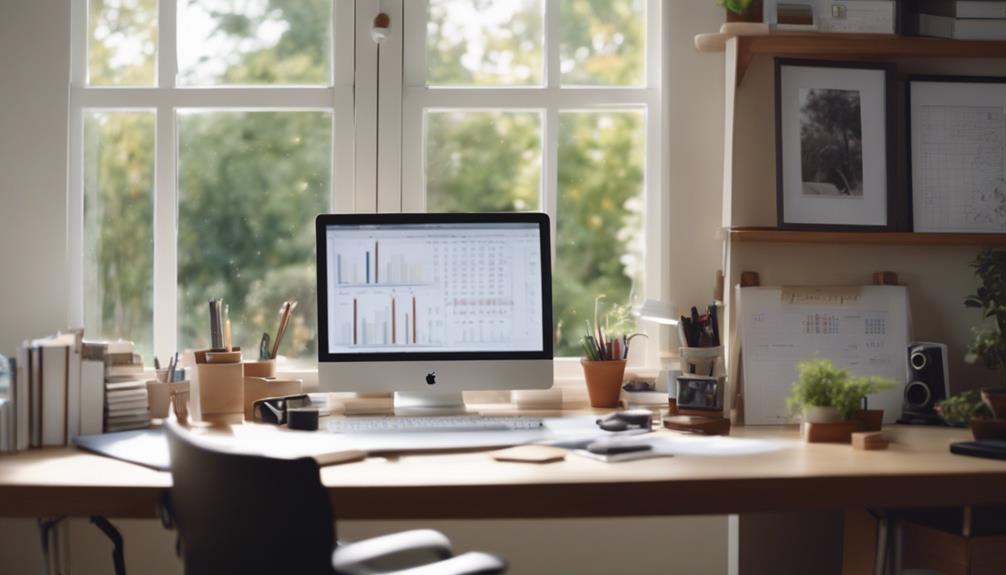
Visualizing progress can be a powerful motivator in your journey to declutter your home office. By setting specific goals and envisioning a clutter-free workspace, I stay focused and inspired.
Picturing the end result helps me create a clear vision of how I want my home office to look and function. Taking before and after photos provides a tangible representation of my progress, making the journey more rewarding.
Here are four steps to help you:
- Set specific goals: Define what you want to achieve in each decluttering session.
- Envision a clutter-free workspace: Picture how an organized office will improve productivity.
- Picture the end result: Keep a clear image of your ideal workspace in mind.
- Take before and after photos: Document your progress visually to stay motivated.
Digitize Documents
Digitizing documents can transform your home office by eliminating piles of paper and creating a more streamlined workspace. I start by scanning important papers and converting them into digital files. This simple step not only reduces physical clutter but also enhances organization. Using cloud storage, I can access these files from anywhere, providing seamless work flexibility. Digital files are secure and can be easily backed up, ensuring data protection. By digitizing documents, I save space and eliminate the need for bulky filing cabinets. Here's a quick comparison:
| Traditional Paper Storage | Digital Storage |
|---|---|
| Bulky filing cabinets | Cloud storage |
| Hard to search | Easy to access |
| Prone to damage | Secure and backed up |
| Takes up space | Space-saving |
Build Habits
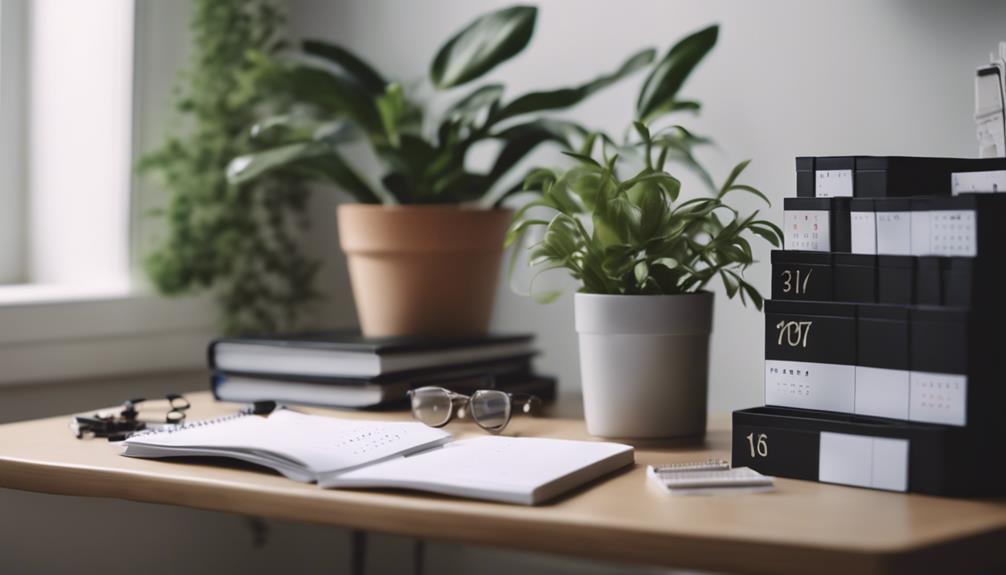
To keep my home office tidy, I establish a daily cleaning routine and stick to it.
I also manage my time effectively by scheduling regular decluttering sessions and adopting a minimalist mindset.
These habits help me maintain a productive and organized workspace.
Daily Cleaning Routine
Establishing a daily cleaning routine in your home office helps maintain a clutter-free and productive workspace. It's important to declutter and organize regularly to prevent paper clutter and other distractions.
Here's my systematic approach:
- Clear work surfaces: Begin by tidying up your desk and any other surfaces. Remove unnecessary items that tend to accumulate.
- Organize paperwork: Sort through paper clutter and file documents appropriately. Consider digitizing important papers to reduce physical clutter.
- Discard trash: Empty your trash bin and recycle any disposable items. This keeps the environment clean and fresh.
- Wipe down surfaces: Quickly wipe down your desk, keyboard, and other frequently used areas to maintain cleanliness.
With these steps, your home office will stay organized and efficient.
Time Management Strategies
Building on your daily cleaning routine, let's explore effective time management strategies to make decluttering a consistent habit.
Start by establishing a decluttering schedule, allocating specific time slots each week dedicated solely to organizing. Using time management tools like timers or apps can help you stay on track.
One effective method is the Pomodoro Technique: set a timer for 25 minutes of focused decluttering, then take a 5-minute break. This keeps the task manageable and less overwhelming.
Lastly, set achievable goals for each session, such as organizing a single drawer or shelf. Reward yourself after reaching these milestones to reinforce positive habits.
These strategies will streamline your decluttering process, making it an integral part of your routine.
Minimalist Mindset Adoption
Adopting a minimalist mindset in your home office starts with focusing on quality over quantity, ensuring that each item serves a purpose. By embracing minimalism, I can reduce stress, improve focus, and enhance productivity.
To build these habits, I follow a few key steps:
- Declutter regularly: I set aside time weekly to clear out unnecessary items.
- Evaluate necessity: I routinely assess whether each item is essential to my work.
- Prioritize quality: I invest in durable, high-quality tools and furniture that last.
- Practice mindfulness: I stay conscious of what I bring into my workspace, avoiding clutter build-up.
These steps help maintain a clean, efficient, and inspiring environment, fostering a minimalist mindset.
Frequently Asked Questions
How Do You Organize a Cluttered Office?
I start by optimizing cord management and space utilization. I use storage solutions like bins and shelves. Minimalist decor helps clear my mind. Workflow optimization guarantees efficiency. Regular decluttering keeps everything tidy and functional.
How Do I Keep My Home Office Tidy?
I keep my home office tidy by prioritizing cable management, using minimalist decor, and implementing daily routines. I focus on digital organization and utilize innovative storage solutions to maintain an uncluttered, efficient workspace.
How to Purge Office Supplies?
Did you know we waste about 1.5 hours a day searching for things? I'll color code, use label makers, and donate extras. Recycle bins and innovative storage solutions will keep my office organized and efficient.
How to Declutter a Desk at Home?
When I declutter my desk at home, I prioritize minimalist decor and focus on cable management. I use drawer organizers for supplies, opt for paperless solutions, and guarantee efficient desk lighting to create a streamlined workspace.
Conclusion
So, after all that effort, my home office now looks like a minimalist's dream. Funny how it takes so much work to have so little, right?
But seriously, keeping only essentials, prioritizing practicality, and managing cables has made a world of difference. Sorting, categorizing, and digitizing documents has never felt so rewarding.
And let's not forget building habits—because who doesn't love a good routine? In the end, less really does become more.


